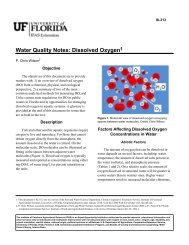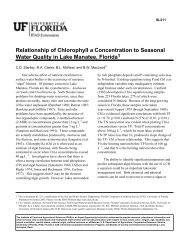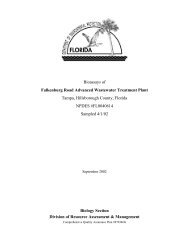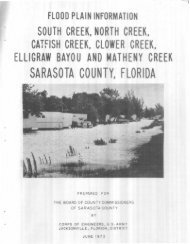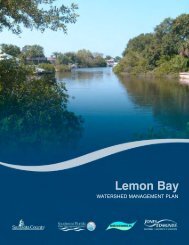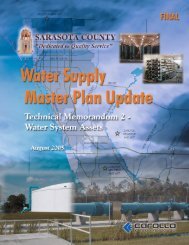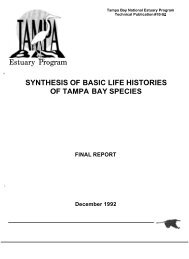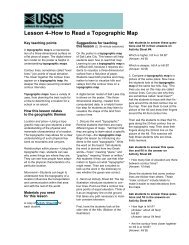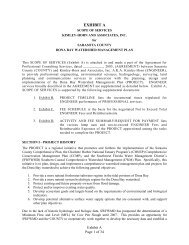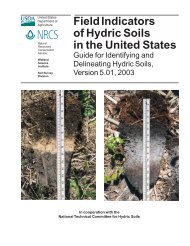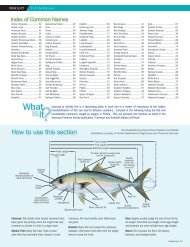Peace and Myakka River Water Quality Summary 2002 - Southwest ...
Peace and Myakka River Water Quality Summary 2002 - Southwest ...
Peace and Myakka River Water Quality Summary 2002 - Southwest ...
Create successful ePaper yourself
Turn your PDF publications into a flip-book with our unique Google optimized e-Paper software.
1.0 INTRODUCTION1.1 BACKGROUNDDuring the 1980’s <strong>and</strong> 1990’s a number of federal, state <strong>and</strong> regional resourcemanagement programs designated the Charlotte Harbor watershed as a prioritymanagement area. Protection <strong>and</strong> enhancement of water quality for use by people <strong>and</strong>wildlife are fundamental goals of these watershed management efforts.In 1996 a watershed assessment report funded by the <strong>Southwest</strong> Florida <strong>Water</strong>Management District emphasized the important role that monitoring data play insupporting sound watershed management decisions, <strong>and</strong> recommended that morefrequent (e.g., biweekly or monthly) water quality monitoring be initiated at selectedsites in the <strong>Peace</strong> <strong>and</strong> <strong>Myakka</strong> <strong>River</strong> basins (Squires et al. 1996). Thatrecommendation, <strong>and</strong> concerns about the sufficiency of the information currentlyavailable on water quality conditions in the Charlotte Harbor watershed, motivated anumber of organizations to work cooperatively to implement the water quality monitoring<strong>and</strong> assessment project covered in this report.Using funds provided by the District <strong>and</strong> the <strong>Peace</strong> <strong>River</strong>/Manasota Regional <strong>Water</strong>Supply Authority, <strong>and</strong> in-kind services provided by the Charlotte Harbor EnvironmentalCenter, the District, the Florida Department of Environmental Protection, <strong>and</strong> the City ofPunta Gorda, the cooperating organizations initiated a monthly water quality monitoringprogram at a number of stations in the <strong>Peace</strong> <strong>River</strong> watershed in October 1997. InOctober 1998 the program was exp<strong>and</strong>ed to include an additional station in the <strong>Peace</strong><strong>River</strong> watershed <strong>and</strong> a number of stations in the <strong>Myakka</strong> <strong>River</strong> basin. In order toprovide information on annual mass loadings of priority water quality constituents eachof these stations was co-located with an existing stream gaging station, wheremeasurements of stream flow are recorded on a continuous basis by the U.S.Geological Survey. (The locations of these USGS gaging stations, which for technicalreasons must be sited in the freshwater, non-tidal portions of a watershed, are shown inFig. 1 <strong>and</strong> summarized in Table 1 below.)To encourage timely analysis <strong>and</strong> dissemination of the water quality data collectedduring the initial years of the cooperative monitoring program, the Charlotte HarborNational Estuary Program provided funding for the preparation of three annual projectreports (CHEC 1999, 2000, 2001). To help readers interpret this information in thecontext of regional water quality trends, the initial reports also included analyses ofwater quality <strong>and</strong> streamflow trends occurring at selected stations in the <strong>Peace</strong> <strong>and</strong><strong>Myakka</strong> <strong>River</strong> basins during the years 1970 through 1998.In addition to the watershed monitoring program, the District, as part of its Surface<strong>Water</strong> Improvement <strong>and</strong> Management (SWIM) program, also carried out a monitoringproject in Charlotte Harbor that included portions of the most downstream, tidallyinfluencedreaches of the <strong>Peace</strong> <strong>and</strong> <strong>Myakka</strong> rivers. (The locations of these stationsare shown in Fig. 18, below). The SWIM monitoring project began in January 1993 <strong>and</strong>was ended in December 2000, in preparation for a multi-agency monitoring program1



